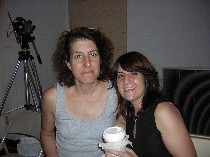
Yesterday included a dash to the last of the Food for Thought brown bag lunches at University of the Arts, which are public slide lectures by visiting artists organized for the students in the Summer MFA program. Yesterday’s speaker was sculptor and installation artist Bonnie Collura, who teaches at Tyler. Collura recently won a Guggenheim, right, before the talk, seated with Jennie Shanker).
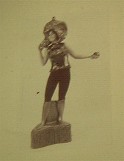
Her work, with its complex narratives, quickly brought to my mind Matthew Ritchie, but apparently I wasn’t the first to have this thought because Collura mentioned during her talk that he was not a good comparison. The difference, she said, was that her work didn’t require a roadmap to interpret it, that her work was open to whatever narratives the viewer brought. Her own narratives were just a tool, a path for her to follow as an artist (image, Collura dressed as a toy heroine in pieces from her Yale MFA final project).
I also wondered if she was distancing herself from Ritchie because of the male vs. female thing. After all, Ritchie’s work has a huge dose of male ego underneath its expansive scale, its map-making and myth-making, its arcane references to times past, and its mumbo-jumbo science.
The mix of feminism and Bernini also made me think of Lynda Benglis.
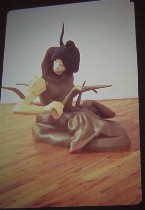
I have to say that Collura also has a hefty dose of ego. But for her it’s political, a resurrection of female empowerment and a meditation on male and female roles in creation and resurrection that carries through all her work. She has crones and goddesses and even her Snow White isn’t Disney’s passive morsel. Rather Collura re-invests her with the power of the Persephone myth, which has strong parallels (left, “My White”).
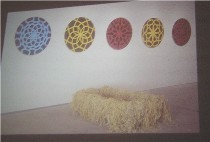
As for Snow White’s prince, who effects her resurrection in the hands of Disney, I presume Collura’s “Prince” is in part a reference to that. “The Prince Project” is all about resurrections and the creation/Frankenstein/Golem theme. The prince figure, which is still in the creation stage, has imagery of four different males–Abraham Lincoln, C3PO, St. Sebastian and Jesus. And other parts of the project include a number of different ways of making artificial life. This image is “Dust,” one of the mythic sources from which life is made (right, “Dust”).
She said the bookends to her work were Bernini and Walt Disney. So we’ve got Bernini’s torque and technique paired with Snow White and Mickey. And these ideas and images carry through from the earliest work she showed to “Prince.”
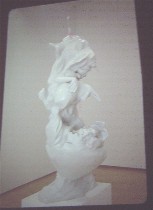
Just as the sculptures twist and interlock a number of symbolic persona, so does the entire body of work twist and interlock, imagery and ideas carrying over from one piece to the next. Trapped in all of Collura’s complex sculptures, installations and drawings are myths and tales and art history references, so heavily layered and intertwined that they challenge the experience of just looking (left, “Snowman”).
Collura said getting people to look and walk all around her sculptures was harder and harder because everyone is accustomed to passive video-game looking. So she takes it as a challenge to make the piece look thoroughly different from every angle–a reward for the intent looker. She also works to block the view, force the viewer to circulate around the work, and to have things give different impressions from different distances, so as lookers approach her pieces, they keep discovering new impressions.
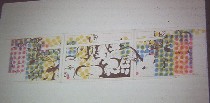
That same impulse to block the view comes through in her drawings, in which she uses a number of distractions, including colored dots, to create a top-layer impression that must be gotten beneath and looked beyond.
Collura talked about the sculptures by name, as if we should already know what (or who) she is talking about. She’s so engrossed with what she’s doing, and she has noticed it and said that she was concerned about how the studio becomes such a central, all-encompassing part of her life and she was looking for a little balance.
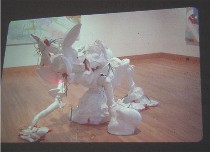
Her original materials were insulation board and a plaster-based coating. More recently she has been casting rather than carving and coating. She’s using more durable materials like resins and metals. My favorite aspects of her work were the toy, mass-production and popular culture references, which seem to me to be overpowered more recently by the art historical, the textual and the mythical (left, “Decoy).
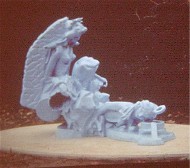
My favorite tidbit in the talk was that in preparing a permanent outdoor installation in Hanover, Germany, she was inspired by the stereotyped German images from Great Adventure–her only experience of German culture in her childhood. The imagery in the sculpture includes three women at three different ages, and the youngest, at the bottom, is submerged regularly when the three rivers that converge there overflow their banks (right, “Triad”).
For our other reports on this summer’s Food for Thought talks, go here (Allan McCollum) and here (Elaine Reichek).









